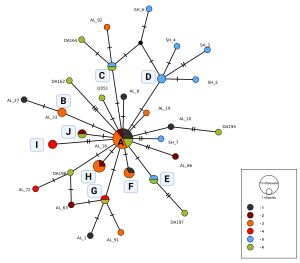 Dmitry S. Korobova,#, Eugenia S. Boulyginab,##, Natalia V. Slobodovab,c,###, Fedor S. Sharkob,####, Artem V. Nedoluzhkod,#####
Dmitry S. Korobova,#, Eugenia S. Boulyginab,##, Natalia V. Slobodovab,c,###, Fedor S. Sharkob,####, Artem V. Nedoluzhkod,#####
a Institute of Archaeology RAS, Moscow, Russia
b “Kurchatov Institute” National Research Centre, Moscow, Russia
c National Research University Higher School of Economics, Moscow, Russia
d European University at Saint Petersburg, St. Petersburg, Russia
#Е-mail: dkorobov@mail.ru
##E-mail: eugenia.bulygina@gmail.com
###E-mail: nv.slobodova@gmail.com
####E-mail: fedosic@gmail.com
#####E-mail: nedoluzhko@gmail.com
Keywords: palaeogenetics, mitochondrial DNA, North Caucasus, Koban culture, Alanian culture, Sarmatian period.
This study is the first attempt to analyze the genetic diversity of the Central Ciscaucasia population during the Late Bronze Age – Early Iron Age and Early Middle Ages. The authors analyzed 120 samples from 10 burial grounds of the Koban and Alan archaeological cultures, as well as representatives of the Middle Sarmatian culture and the North Caucasian population of the Sarmatian period. Data on the variability of mitochondrial DNA (mtDNA) of 71 individuals were obtained. An analysis of the previously collected and published information allows concluding that the analyzed populations are characterized by a significant diversity of mtDNA with a predominance of West Eurasian mitochondrial haplogroups. East Eurasian lines of inheritance can be traced in small numbers among the population of the Koban culture (5%), as well as among the Sarmatian (14%) and Alanian populations (11%). The most common lines of Western Eurasian origin are different variants of haplogroups H, U and N. At the same time, a significant diversity of mtDNA haplogroups is observed at all burial sites, except for the Kich-Malka II burial ground, where during the 7th century BC – the early 6th century AD the succession of individuals on the maternal line was recorded, represented by haplogroup H2a2a1. Study in the latter requires a more detailed approach using whole genome sequencing. Comparison of the analyzed sample with previously published data on the genetic portrait of the North Caucasus population in the Early and Middle Bronze Age makes it possible to conclude that representatives of the East Eurasian cluster of mtDNA haplogroups arrived in the Central Ciscaucasia rather late, it was probably associated with contacts between the Koban culture carriers and the nomadic steppe population.
DOI: 10.31857/S0869606323010129







